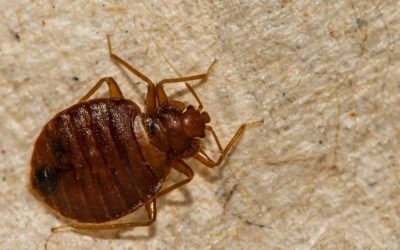Bed bugs are found in 1/5th of U.S. homes, and often confused with fleas, lice, and cockroaches. They often go weeks – if not months – without being noticed.
So how do you know when these blood drinking insects have infested?
Here are some common signs to look for.
Bed Bug Bites
While bed bug bites are usually the first sign people notice, there are a couple of reasons you shouldn’t use them alone to confirm bed bugs.
First, each person’s reaction to bed bug bites is different. Some react with raised, red, itchy bumps, others blister, and still others have no reaction at all. It’s common for people living in the same home to have very different reactions to the same bites.
It’s also extremely difficult to differentiate bed bug bites from other bug bites such as mosquitos, fleas, or spiders.
Because of this, the following signs are more reliable signs bed bugs have set up home – in yours.
Signs of Bed Bugs
1)
Blood stains on sheets
Look for small, rust colored stains on sheets where you sleep. Keep in mind, these are incredibly small blood stains, something you probably won’t notice unless you look closely.
These blood stains can come from two sources: your skin bleeding after being bitten, and the bed bugs themselves.
When a bed bug is feeding, it releases an anticoagulant – this allows blood to flow more freely. Because of this, people will sometimes continue to bleed, even after a bed bug has finished its meal, leaving small blood stains on their sheets.
The other cause of blood stains is when you squish an unlucky bed bug when moving in your sleep. While this doesn’t kill them, their engorged bodies may spurt out some of their recent meal, leaving dark blood stains behind.
2)
Dark stains
About the size of a tip of a pen, these dark stains are extremely difficult to remove, and often smear.
While similar to blood stains, they’re much darker in color, and smaller. These stains are actually fecal matter (digested blood) of bed bugs meals.

3)
Shell casings
Shell casings are a sure sign of bed bugs. In order to reach the next stage of life, bed bugs need to shed their skin (rather like a snake). This happens five times during their life cycle. What’s left behind is a translucent yellow to brown casing, the outer ‘shell’ of a bed bug.
4)
Eggs
About the size of a pinhead, these pearl-white eggs are very difficult to see. Similar in shape to a grain of rice (albeit much smaller), these eggs can be found in clusters or by themselves.
Eggs are attached to surfaces with a sticky substance, meaning they can be found anywhere including the underside of a mattress, bed legs, and walls.
The more blood a female drinks, the more eggs she’ll lay. If fed well (once a week), a female bed bug can lay anywhere from 1 to 7 eggs a day. After 10 days, she’ll need to have a blood meal to keep laying eggs.
The length of time it takes for eggs to hatch depends on the temperature. In favorable conditions (avg. 70 F.) they can hatch in 6 to 9 days. In colder conditions (avg. 50 F), they can take up to 28 days to hatch.

5)
Scent
If you notice a musty, sickly-sweet scent coming from a clean room, the culprit may be bed bugs.
Keep in mind, an infestation has to be pretty advanced in order to notice the smell. Some people describe it as similar to coriander, others say rotten raspberries, and others describe it as acidic.
However it smells to you, the smell comes from a mixture of pheromones bed bugs give off and their excretion (the dark spots mentioned above).
6)
Live Bugs
The easiest sign to know for certain you have bed bugs is when you find the bugs themselves.
Bed bugs are about the size of an apple seed with small, flat discs as bodies unless they’ve just fed; then their bodies expand and elongate and change to a darker color. This image is of an unfed bed bug.
They can be easily confused with baby cockroaches, lice, fleas, ticks, and beetles.
This is a useful resource that describes how to identify bed bugs.

If you’re located in Arkansas, PureNature offers reliable pest control solutions experienced in bed bugs control safe for the whole family.



